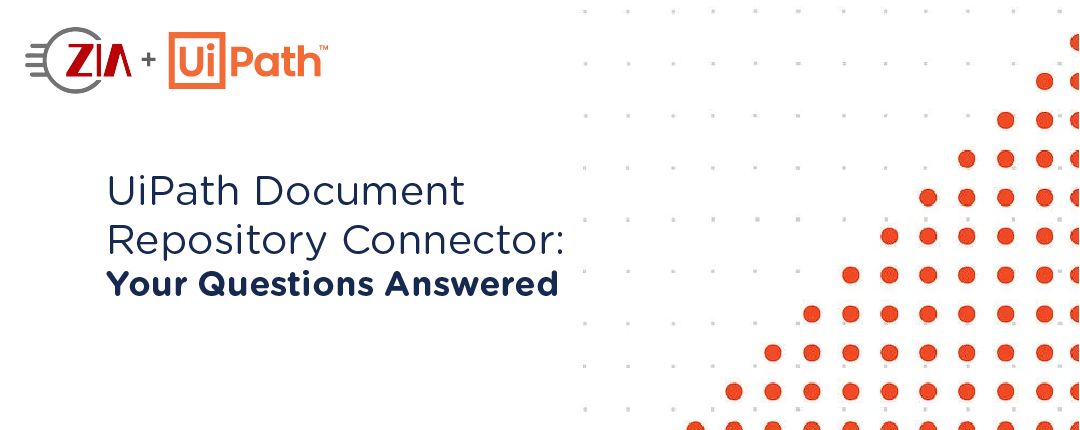Zia is the first company on the UiPath marketplace to provide an “abstraction” Activity Pack that allows access to multiple Content Management Systems using the same API. (https://marketplace.uipath.com/listings/zia-document-repository-activities ). The Activity pack is accessible on the UiPath Marketplace.
UiPath is a platform company that provides an end-to-end intelligent automation platform for the new generation of digital businesses. These businesses are building their digital platform using UiPath. These platforms have the following architectural layers:
- An Experience layer.
- A Core Layer that consists of a Lego-styled tiered architecture.
- A Foundational Layer that is built from connectors to the ecosystem partnerships products.
One important part of the Foundational Layer is the common infrastructure components that are used for services such as: Content Management (ECM / CCM), Email, Scheduling, Calendar, etc. If you want to provide a generic solution for the fully automated enterprise, you need to be specific technology independent. This can be achieved by providing a Meta Layer above each specific technology. Doing this allows the same automation code to access different systems. Some of these services already have standard meta APIs that have specific implementations for each technology.
It can be challenging for an enterprise to have multiple systems that perform in a uniform way. Examples of companies who provide technologies like this are Zia for ECM and CCM, and Nylas for emails, calendar, and scheduling. Blue Print Systems provides an abstraction layer for services including, Process Mining, Task Capture, and RPA. This allows companies to use multiple systems with a common interface.
Below, Zia answers questions you may have about the new Activity Pack they developed
-
- Why is Enterprise Content Management(ECM)/Cloud Content Management (CCM) important in the RPA process?
Several processes start with a document, or set of documents. For hyperautomation to work correctly, a system needs to be able to identify both the type of document and the information included. The system’s ability to do that determines how the document is processed. For example, it may start with a workflow, storing and applying a retention, or requesting physical communication. Then, documents are moved to a location for processing, collaboration, or storage. - What are some example use cases of RPA using ECM or CCM?
There are many use cases that can be associated with documents and related to an ECM or CCM system. Below are just a few of those cases.
Accounts Payable:
Let’s say a company receives an invoice. Once a document is identified as an invoice, the system extracts information like the invoice amount, due date, and vendor details. The next interaction is between the invoice processing system and the specific document that is stored in an ECM or CCM system for archival and QC, quality control, and processes.
Mortgage:
A mortgage underwriting process is document heavy. A ton of documents are obtained from the borrower, as well as generated during the loan process. These documents are stored in a system that holds vital metadata for processing, QC, and compliance. That system should also integrate with the LOS and loan origination system for ease of processing and automation.
Insurance:
Speed and accuracy are paramount to a positive customer experience when onboarding a new policyholder. During onboarding, multiple applications and documents are submitted at the same time. It is important that they are checked for completeness and signatures, before they are deemed as “in good order”. Then, they are entered into multiple systems of record. If they’re not in good order, an immediate request is sent back to either the insurance agent or the applicant to ensure quick processing. Once deemed in good order, the information from the various documents is entered into several systems, such as Customer Relationship Management, Billing, Claims, Policy Administration, and closing out the underwriting process. Zia solutions automates this entire process. This can be especially useful during busy seasons as companies have hundreds, if not thousands, of new policyholders to onboard at once. - How do the Zia UiPath Activities help with the creation of these processes?
We find that the point solutions that access ECM/CCM products are limiting because most enterprises have more than one repository. Configuration changes according to the repository being utilized. Further, it becomes difficult when trying to access more than one repository for a single use case. Zia’s tool set of activities allows UiPath developers to access several repositories in a common way. Documents are aggregated under a ‘single pane of glass,’ or migrated from one repository to another. It is also very useful for a single repository to be able to upload, search, and download documents and other utilities. - What does Zia Consulting do?
Zia Consulting is a system integrator that worked in hyperautomation before it was termed. Zia automates complex and repetitive business processes to reduce cost, remove human errors, enable companies to handle fluctuations in the volume of content without a change in headcount, and enhance the user experience.
- Why is Enterprise Content Management(ECM)/Cloud Content Management (CCM) important in the RPA process?
Please contact us to discuss how our new “abstraction” Activity Pack and hyperautomation services can make your business processes more efficient.

ABOUT THE AUTHOR
George Roth, DU Evangelist, UiPath
George was born in Cluj, one of Romania’s most important cities. He studied at the first specialized high school for computer programming. He graduated with an MS in Mathematics and Computer Science from the “Babes Bolyai” University in Cluj in 1980. His career started at the Cluj Territorial Center for Computation (CTCE) where he worked until 1991, when he emigrated to the U.S.
During his early years in the U.S., he worked as a Software Architect on numerous projects for large financial institutions and was the Lead Architect of SUMS (Security Universe Management System), a comprehensive financial data cleansing tool implemented at very large financial institutions in the US and Europe. In 1999, together with a partner, started Recognos Inc. a California Corporation. One year later, George and another partner established Recognos Romania, Inc., a U.S. – Romanian joint venture in Cluj, Romania. George participated in his role as Software Architect in the architecture of the Smart Data Platform, a platform used to extract data from unstructured content.
The platform was acquired by UiPath in April 2018, when George together with other members of the team started to work for UiPath.
George worked in the UiPath Technology Alliances team until May 2022, when he became the Evangelist for Document Understanding for UiPath.
George dedicated his last years to the study and developing applications of the Semantic Technology, NLP and AI in the unstructured content processing.

ABOUT THE AUTHOR
Pat Myers, EVP and Co-Founder
Pat has 20+ years of software architecture and engineering experience across many industries. He is an Enterprise Content Management and Capture expert and an authority on Robotics Process Automation. Pat’s experience ranges from application development and consulting to sales and business development. He is an author of two editions of Intelligent Document Capture with Ephesoft, and co-developed the original certification training. Over the years, he has taught Ephesoft certification courses internationally. In 2021, he was inducted into the Inc. 5000 Master’s Group. Outside of work, Pat enjoys family time, snowboarding, biking, camping, and making great memories with friends.

